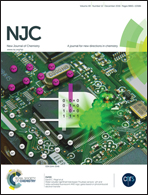Spontaneous vesiculation: a mechanistic insight from the study of hybrid peptide molecules†
Abstract
We report a series of simple acyclic molecules that display spontaneous vesiculation. A closer look at their vesicle formation revealed a toroidal intermediate en route to the final vesicular form. Electron and optical microscopy based imaging along with dye encapsulation using commonly used fluorescent reporters help reveal the inner dynamics of the morphogenesis.


 Please wait while we load your content...
Please wait while we load your content...